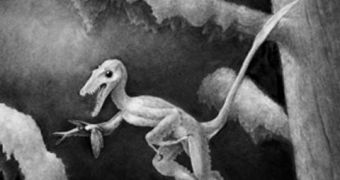A new scientific report, published in the Tuesday issue of the journal Proceedings of the National Academy of Sciences (PNAS), details a new species of dinosaurs that lived more than 75 million years ago. The creature is very similar to the velociraptor dinosaurs that can be seen in the “Jurassic Park” movies, with the only difference being that it is way smaller, roughly the size of a modern-day chicken. Nevertheless, it was carnivorous, and most likely able to inflict serious damage on humans, on account of its speed and large brain.
Velociraptors drew their very name from the fact that they were very fast. They had three claws on each of the two feet they used for locomotion, and the middle one was very extended and curved. This allowed the animals to actually chase prey that was larger than them, because they haunted in packs and could easily jump on the back of dinosaurs and other animals, and “dock” themselves securely there via the large claws.
The animal “probably hunted and ate whatever it could for its size – insects, mammals, amphibians and maybe even baby dinosaurs,” University of Calgary researcher Nicholas Longrich, who has been the author of the PNAS paper, along with colleague Philip J. Currie, says. The most interesting aspect of this discovery, Longrich tells MSNBC in a telephone interview, is that the newly-discovered dinosaur fills a niche in the North American landscape, in that researchers have thus far failed to discover the remains of such small reptiles in the area.
Large and medium-sized ones were known to exist in the region, but no smaller reptiles have been ever found. Now, the velociraptor that was presented to the world on Tuesday actually seems to be a dwarf version of its kind, as its species usually reached 1 to 1.2 meters in height. Weighing in at just about 4 to 5 pounds (2 to 2.5 kilograms), the North American velociraptor was actually about the same size and weight of a chicken, except for the fact that it had long claws, sharp teeth, and could actually run extremely fast.
“It was hard to tell because it was still encased in rock. It is only because I had been studying the Chinese dinosaurs I could tell what it was. Once we got it out of the rock it was a pretty nice specimen,” Longrich explains.

 14 DAY TRIAL //
14 DAY TRIAL //